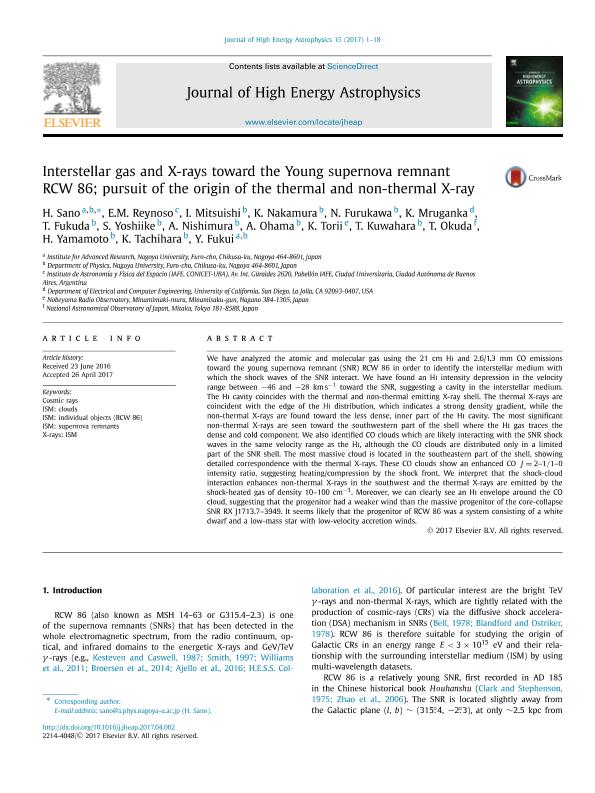Mostrar el registro sencillo del ítem
dc.contributor.author
Sano, H.
dc.contributor.author
Reynoso, Estela Marta

dc.contributor.author
Mitsuishi, I.
dc.contributor.author
Nakamura, K.
dc.contributor.author
Furukawa, N.
dc.contributor.author
Mruganka, K.
dc.contributor.author
Fukuda, T.
dc.contributor.author
Yoshiike, S.
dc.contributor.author
Nishimura, A.
dc.contributor.author
Ohama, A.
dc.contributor.author
Torii, K.
dc.contributor.author
Kuwahara, T.
dc.contributor.author
Okuda, T.
dc.contributor.author
Yamamoto, H.
dc.contributor.author
Tachihara, K.
dc.contributor.author
Fukui, Y.
dc.date.available
2018-01-15T14:54:00Z
dc.date.issued
2017-09
dc.identifier.citation
Sano, H.; Mitsuishi, I.; Fukui, Y.; Tachihara, K.; Reynoso, Estela Marta; Nishimura, A.; Interstellar Gas and X-rays toward the Young Supernova Remnant RCW 86; Pursuit of the Origin of the Thermal and Non-thermal X-ray; Elsevier; Journal of High Energy Astrophysics; 15; 9-2017; 1-18
dc.identifier.issn
2214-4048
dc.identifier.uri
http://hdl.handle.net/11336/33213
dc.description.abstract
We have analyzed the atomic and molecular gas using the 21 cm HI and 2.6/1.3 mm CO emissions toward the young supernova remnant (SNR) RCW 86 in order to identify the interstellar medium with which the shock waves of the SNR interact. We have found an HI intensity depression in the velocity range between -46 and -28 km/s toward the SNR, suggesting a cavity in the interstellar medium. The HI cavity coincides with the thermal and non-thermal emitting X-ray shell. The thermal X-rays are coincident with the edge of the HI distribution, which indicates a strong density gradient, while the non-thermal X-rays are found toward the less dense, inner part of the HI cavity. The most significant non-thermal X-rays are seen toward the southwestern part of the shell where the HI gas traces the dense and cold component. We also identified CO clouds which are likely interacting with the SNR shock waves in the same velocity range as the HI, although the CO clouds are distributed only in a limited part of the SNR shell. The most massive cloud is located in the southeastern part of the shell, showing detailed correspondence with the thermal X-rays. These CO clouds show an enhanced CO J = 2-1/1-0 intensity ratio, suggesting heating/compression by the shock front. We interpret that the shock-cloud interaction enhances non-thermal X-rays in the southwest and the thermal X-rays are emitted by the shock-heated gas of density 10-100 cm-3. Moreover, we can clearly see an HI envelope around the CO cloud, suggesting that the progenitor had a weaker wind than the massive progenitor of the core-collapse SNR RX J1713.7-3949. It seems likely that the progenitor of RCW 86 was a system consisting of a white dwarf and a low-mass star with low-velocity accretion winds.
dc.format
application/pdf
dc.language.iso
eng
dc.publisher
Elsevier
dc.rights
info:eu-repo/semantics/openAccess
dc.rights.uri
https://creativecommons.org/licenses/by-nc-sa/2.5/ar/
dc.subject
Cosmic Rays
dc.subject
Ism: Clouds
dc.subject
Ism: Individual Objects (Rcw 86)
dc.subject
Ism: Supernova Remnants
dc.subject
X-Rays: Ism
dc.subject.classification
Astronomía

dc.subject.classification
Ciencias Físicas

dc.subject.classification
CIENCIAS NATURALES Y EXACTAS

dc.title
Interstellar Gas and X-rays toward the Young Supernova Remnant RCW 86; Pursuit of the Origin of the Thermal and Non-thermal X-ray
dc.type
info:eu-repo/semantics/article
dc.type
info:ar-repo/semantics/artículo
dc.type
info:eu-repo/semantics/publishedVersion
dc.date.updated
2018-01-12T19:44:39Z
dc.journal.volume
15
dc.journal.pagination
1-18
dc.journal.pais
Países Bajos

dc.journal.ciudad
amsterdam
dc.description.fil
Fil: Sano, H.. Nagoya University; Japón
dc.description.fil
Fil: Reynoso, Estela Marta. Consejo Nacional de Investigaciónes Científicas y Técnicas. Oficina de Coordinación Administrativa Ciudad Universitaria. Instituto de Astronomía y Física del Espacio. - Universidad de Buenos Aires. Facultad de Ciencias Exactas y Naturales. Instituto de Astronomía y Física del Espacio; Argentina
dc.description.fil
Fil: Mitsuishi, I.. Nagoya University; Japón
dc.description.fil
Fil: Nakamura, K.. Nagoya University; Japón
dc.description.fil
Fil: Furukawa, N.. Nagoya University; Japón
dc.description.fil
Fil: Mruganka, K.. Department Of Electrical And Computer Engineering; Estados Unidos
dc.description.fil
Fil: Fukuda, T.. Nagoya University; Japón
dc.description.fil
Fil: Yoshiike, S.. Nagoya University; Japón
dc.description.fil
Fil: Nishimura, A.. Nagoya University; Japón
dc.description.fil
Fil: Ohama, A.. Nagoya University; Japón
dc.description.fil
Fil: Torii, K.. Nobeyama Radio Observatory; Japón
dc.description.fil
Fil: Kuwahara, T.. Nagoya University; Japón
dc.description.fil
Fil: Okuda, T.. National Astronomical Observatory Of Japan; Japón
dc.description.fil
Fil: Yamamoto, H.. Nagoya University; Japón
dc.description.fil
Fil: Tachihara, K.. Nagoya University; Japón
dc.description.fil
Fil: Fukui, Y.. Nagoya University; Japón
dc.journal.title
Journal of High Energy Astrophysics
dc.relation.alternativeid
info:eu-repo/semantics/altIdentifier/url/http://adsabs.harvard.edu/abs/2016arXiv160607745S
dc.relation.alternativeid
info:eu-repo/semantics/altIdentifier/url/https://www.sciencedirect.com/science/article/pii/S2214404817300411
dc.relation.alternativeid
info:eu-repo/semantics/altIdentifier/doi/http://dx.doi.org/10.1016/j.jheap.2017.04.002
dc.relation.alternativeid
info:eu-repo/semantics/altIdentifier/url/https://arxiv.org/abs/1606.07745
Archivos asociados
